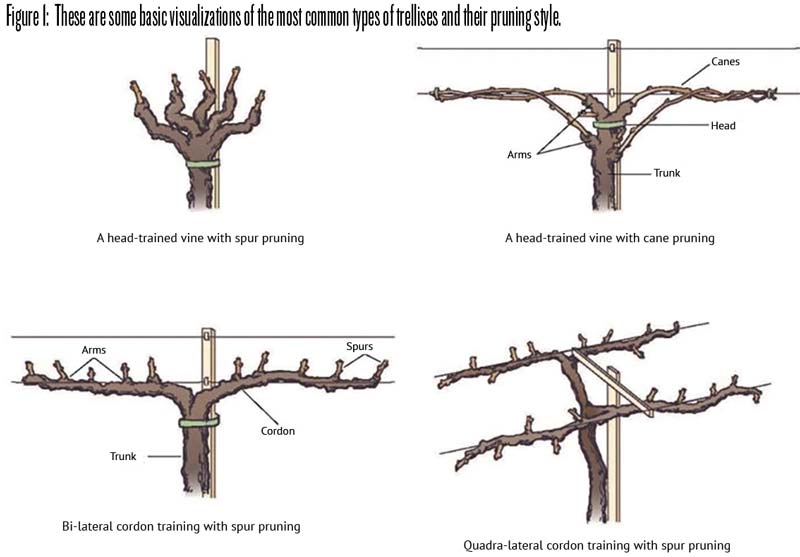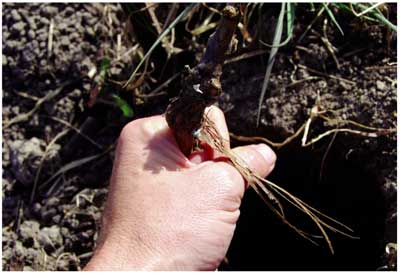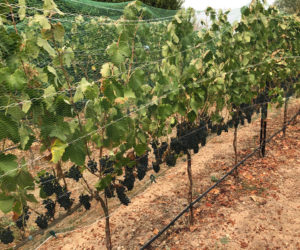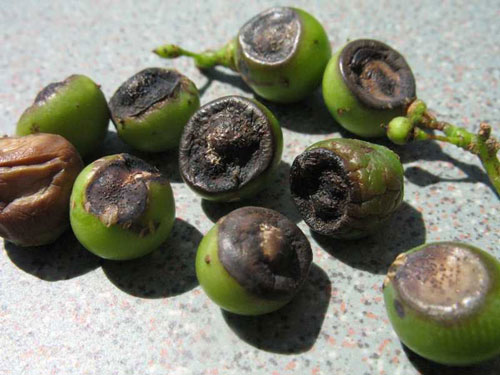In the June-July 2022 issue, I discussed where to start when you finally have decided you are determined to create your own backyard vineyard. It covered the concepts of site planning and some of the required prep work such as soil amendments. For the purpose of these articles I am considering a small-scale or backyard vineyard to be at least a dozen vines, and an acre or less. In general, a vineyard of this size would:
- Be small enough that one adult (two at most) will be able to farm and harvest the vineyard without a lot of outside help.
- Enable those who plan, plant, farm, and harvest to understand winemaking from the most important possible perspective: How to improve wine from ground to glass. Farming your own grapes opens up whole new avenues of understanding the viticulture and enology processes.
- Produce no less than 5 gallons (19 L) of wine (12–20 highly productive vines) and as many as a few 55-gallon (225-L) barrels. Since vine yield is highly variable I would try to plant at least 20–40 vines to make sure you can fill and top a 5-gallon (19-L) carboy.
Trellising in the Vineyard
There is no doubt that you need to visit some local vineyards before deciding on a trellising system. Choosing trellising is a complicated process and one that cannot be explained in a few short paragraphs. If I learned anything at UC-Davis, it’s that viticulture is site specific in the extreme. That means what works here in Lompoc, California will likely not be an efficient trellising system in Virginia. First we need to understand how to decide on row and vine spacing, then we can come back and discuss trellising options a bit.
Vine Spacing
Viticulturists often express vine spacing with two measurements, such as “twelve-by-six,” “eight-by-four,” or “three-by-three.” The first number represents the space between rows. This means that there might be twelve feet (3.7 m) in between the end-posts. This first measurement dictates what kind of equipment is appropriate for the vineyard. 12-ft. (3.7-m) row spacing will allow almost any kind of tractor, full-sized pickup truck, etc., to traverse the rows. 6- to 8-ft. (1.8- to 2.4-m) row spacing is generally the tightest that allows narrow tractors to work in the vineyard.
One might be able to squeeze an ATV down 4-ft. (1.2-m) rows, but take the rows to 3 ft. (1 m) and get prepared to do all cultural practices (weed control, spraying, fertilization, compost application, leaf removal, shoot positioning, harvest, etc.) by hand or with prohibitively expensive “over the row” French tractors that can actually straddle tight rows, with the operator riding in a compartment above the vines.
The second number expressed (e.g., eight-by-four) represents the distance between vine trunks within a row. This number (along with row spacing) will dictate vine density per acre, will impact both yield-per-plant and yield-per-acre, and will also impact how the vines compete with each other for available water and nutrients.
Vineyard spacing is a hot topic in wine-farming circles. The debate has become a high-interest issue with home viticulturists around the globe. There was a time when anything tighter than 12 ft. (3.7 m) between rows and 6 ft. (1.8 m) between plants was considered a high-density planting. Indeed, many of the greatest vineyards in Napa Valley are still planted on this kind of “wide” spacing. But in the last two decades, and the last 5–10 years specifically, high-density plantings (spacing as close as 3 ft. x 3 ft. or 1 m x 1 m) have become widespread, extreme examples of land-use efficiency. Even though squeezing thousands of vines into a one-acre planting seems a perfect strategy for a backyard vineyardist, there is plenty of evidence that high-density vineyards can be extremely problematic on most soil types.
Choosing trellising is a complicated process and one that cannot be explained in a few short paragraphs.
So how does an amateur viticulturist best match a potential home vineyard site to a specific spacing arrangement? The answer is not necessarily complicated, but does require a good deal of thought, practice, and planning. Let’s get down to the nuts and bolts of how to decide on spacing, and how that decision will impact fruit quality, canopy density, and labor issues. First let’s look at how vine spacing effects vineyard issues and wine quality, and then we’ll answer some questions to help you decide what spacing would be well suited to your backyard or small vineyard planting.
If you remember anything from this article, remember this: Vineyards should be efficient to farm and vine spacing should be based on the anticipated vigor of the vineyard. What does this mean to you? The amount of work you will have to put into your vineyard is dictated by how well you match vine vigor (as expressed by soil fertility and climate) to a trellising and spacing arrangement that perfectly harnesses that vigor into an appropriate “system.”
Hypothetical Vineyard Trellising/Spacing Problem
Let me give you an example. I have a professional acquaintance that asked me to consult on a vineyard project gone wrong. This was the worst kind of consulting job — one where the decisions had all been made and implemented in a completely incorrect fashion. The vineyard owner had gone to Burgundy, France and saw beautiful, stunted little Pinot Noir vines all arranged in meter-by-meter (3 ft.-by-3 ft.) fashion and decided that he wanted the same type of vineyard on a small one-acre slope at his home in the Santa Ynez Valley in California.
Mistake number one: Don’t let aesthetics drive a planting project, and never base your vineyard design on the vigor and climate of a site 6,000 miles (10,000 km) away.
The soil of the Santa Ynez site was highly vigorous, nutrient-rich, and deep. The vines sprawled out with canes eight feet (2.4 m) and longer, and the more the owner tried to hedge the vines, the more lateral shoots appeared and clogged up the fruiting zone. Those beautiful 3-ft. (1-m) rows became an impenetrable jungle of shoots and foliage — you couldn’t work the vines without a machete and you might imagine how difficult it was to get sun exposure on the fruit, let alone find the clusters when harvest time arrived. This vineyardist assumed that high-density planting reduces vigor significantly. Competition does exist between vines, but not at a rate that will turn a high-vigor site into an appropriate location for a three-by-three or meter-by-meter system.

Bottom line — high-density planting is only appropriate on low to medium-low vigor sites where shoots rarely grow more than 4–6 ft. (1.2–1.8 m) per season. Sites that are appropriate for low-vigor trellising, such as a system that uses vertical shoot positioning (VSP) wires to direct all growth up and out of the way of the fruiting zone, are usually appropriate for high-density planting. Medium- to high-vigor vineyard sites are much more efficient to farm with at least 8 ft. (2.4 m) between rows (to allow a few feet for shoots sprawling and draping), and 6 ft. (1.8 m) in between plants, in order to give each vine ample space to spread its foliage and ripen a crop load.
So let’s look at some specific considerations for determining an appropriate vine-row spacing arrangement for a small vineyard.
Choosing A Cultivar
Choosing the right grape variety for your small-scale vineyard is crucial. Try to get as much data as you can on local, successful wine grape vineyards. Find out what they are growing with success that will make a style of wine you enjoy and would like to emulate. Some grape varieties are more vigorous than others. Pinot Noir is generally less vigorous than Syrah or Grenache, so Pinot Noir is generally a better candidate for high-density planting, and Rhône varietals are better suited on a wide-spacing arrangement, unless the site is extremely low-vigor. More than nine out of ten successful high-density plantings I’ve visited have been Pinot Noir.
Read up about the grape you want to grow and try to decide if it will be low-, medium-, or high-vigor in your soil/location. This will be the number one consideration for trellising and pruning style. Low-vigor is best for head-trained vines, low- and medium-vigor for VSP trellis, and lyre or quadrilateral trellis styles for high-vigor.
Rootstock
It’s a great idea to check with your grapevine nursery to see if they have rootstocks that can moderate (or increase) vigor to a level that will allow you to tweak your vine spacing to a specification that pleases you. Don’t expect miracles with rootstock though — they won’t guarantee to lower or raise vigor — they have a small, but measurable effect on vine growth.
There are high-, medium-, and low-vigor rootstocks and choosing the right combination can save you lots of hedging (overly vigorous) or fertilizing (low-vigor) later on. Careful research and pestering vine-growing neighbors about their spacing and rootstock combinations will likely steer you in the right direction. Rootstock will also help protect your vines against soil-borne pests such as phylloxera and nematodes — so knowing if you have these pests will certainly influence your decision on which rootstock to choose or whether you can plant own-rooted grapevines.
Training-trellising system
Low-vigor sites that are appropriate for VSP systems (which are basically a series of staggered horizontal wires in which the growing shoots are tucked into to direct all the growth up into a curtain of vertical foliage) are usually more adaptable for higher-density grapevines plantings. Head-trained vines, which means each year the vines will be pruned back to a woody head, require even spacing that allows them to spread their shoots, and not be crowded by their vine neighbors.
Simple backyard trellising made of posts and wire should allow as much space between the rows as the height measurement of an average vine in full growth. For example, if your vines grow up to eight-feet (2.4-m) high they should have at least eight feet (2.4 m) between the rows to keep shading at a minimum. If you use fancy quadrilateral or split-canopy trellising (vines that have two cordons, and thereby grow two fruiting areas on two separate wires, spread horizontally), the rows have to give the vines ample room to grow and spread shoots to either side of the canopy.
It should also be noted here that the closer the in-row vine spacing becomes, the less wood, or buds, should be retained at pruning for producing crop the following year. The main concern for the development of any vineyard should be designing a system that keeps canopy density at an optimal balance so there’s ample sun exposure on the fruit and in the “renewal zone” (the area where buds determine the following year’s crop as a function of sun accumulation).
Why do we care that fruit is not shaded? Not only does shaded fruit have more problems with disease, mildew, and rot but it also accumulates less sugar, has higher pH, higher malic acid, less color and phenolic compounds, and shows increased vegetal/herbaceous character. That’s a pretty good list of things to avoid, so choosing an appropriate spacing for our vineyard can do wonders for potential fruit and wine quality. Keep this in mind as we progress in our study of vine spacing: The main concern in developing vineyard spacing is to keep the fruit zone open to sun and air, eliminating cluster-shading leaves, lateral shoots, and over-cropped clusters that are all jumbled together.
High-end winemakers often seek smaller vines with increased sun exposure on clusters, and the “mythology” of the high-density European vineyards makes this scenario even more attractive. Many winemakers admit that smaller vines with a light crop, in balance, produce high-quality wine and that high-density vineyard design, if used correctly, can increase vine competition to keep vine vigor somewhat in check.
Soil depth, water availability and fertility: I won’t get too technical here, but deep, fertile soils with high macronutrient (NPK) levels will usually translate into high-vigor vines that will require wider spacing (8 ft. x 6 ft./2.5 m x 1.8 m, at least). Low nitrogen levels in soil (soils that are rocky, shallow, have clay restrictive layers or are hillside oriented) may have less vigor and may be more appropriate for tighter spacing — between 8 ft. x 4 ft. (2.5 m x 1.2 m) and 3 ft. x 3 ft. (1 m x 1 m).
Remember that as planting density increases the competition between vines will result in some measurable reduction of vigor. In an extremely infertile site, high-density planting might not be appropriate either. You may want to give the vines a little ‘breathing room’, so they can spread out their root system without having to compete with their neighbors (8 ft. x 4 ft./2.5 m x 1.2 m seems appropriate to me for this type of situation).
Competition between closely planted vines is mainly for water. Many viticulturists note that supplemental irrigation is often required in high-density vineyards, especially near the end of the growing season when the soil is drying quickly and the vines are fighting it out for the tiny amount of water available beneath the ground. Remember that you can tweak the vigor of your site by judicious nitrogen applications to increase vigor or by applying less water in the early season to decrease vigor.
Equipment Available
If your tractor is 6 ft. (1.8 m) wide, your rows should be at least 8–10 ft. (2.4–3 m) wide. If you have an ATV with a little sprayer on the back, it should be able to fit comfortably down the row without running over errant shoots. If you have no equipment, well . . . your options are unlimited and you may want to pack some extra vines in to increase your land-use efficiency.
First determine your potential vigor by either planting a few vines near your house or in a garden, then determine your optimal spacing. Finally take into consideration what type of equipment you have or wish to purchase to make the farming easier. Will you need to mow between rows? Can you use an ATV, wheelbarrow, or even a horse and cart to help collect the fruit during harvest? Can you use a neighbor’s tractor three times a year to till, spray, or harvest? Will you have to spray fungicide by hand? Is there enough room between rows to move comfortably and freely through the vineyard to work? These are questions that need to be answered before the vineyard is planted. Carefully working through these issues now will save you untold hours of toil trying to fix problems that should have been solved by vine row spacing design.
Planting Vines
After your trellising and irrigation (covered in the June-July 2022 issue) are set up, tested, and functioning perfectly; you should be ready to plant some grapevines. Planting usually occurs in late spring after the threat of frost has passed. I suggest using dormant grapevines and not “green-growing” vines. My rates of success with dormant vines have proven significantly higher than using green-growing vines.
If you receive your dormant vines from refrigerated storage, let them acclimate outside in the shade for about a week. Keep the vines moist and in the material (usually moist wood chips) until the morning of planting. At that time fill a 5-gal. (19-L) plastic bucket halfway with water, put the vines in roots first, and carry the vines 20–40 at a time into the vineyard for planting.

Dig a hole 18–20 in. (45–50 cm) deep in the soil. Do not compact the soil on the sides of the hole. I know of a few viticulturists that sprinkle broken shards of wine bottles in the hole before dropping the plant in, saying that the broken glass will keep gophers and burrowing pests from eating the roots. If you do this wear gloves and eyewear . . . and be careful. Some viticulturists also dip the roots in a solution of mycorrhizae fungus, which will increase the plant’s ability to uptake water and nutrients.
Trim the root tips of the dormant vine and drop it in the hole, roots first. Make sure the graft union, which is the calloused bump where the rootstock meets the scion wood, is 4–6 in. (10–15 cm) above the final soil level. If you bury the graft union, the ‘scion’ material (Pinot Noir clone 667, for example) will begin creating roots, and will take over the root system and make the rootstock useless. After the soil has been compacted and replaced (I use a sawed-off hoe to plant and use the blunt end to pack the dirt back in around the vine), you need to dig up some extra, fluffy soil to mound over the exposed part of the vine. Pile the soft soil 1–2 in. (2.5–5 cm) over the part of the dormant vine sticking out of the ground.
When you see substantial growth peeking out of the soil mound (some weeks later), gently remove the soil mound and allow the vine to grow as usual. Remove all the shoots but the strongest, and gently tie the growing shoot to the training stake with ½-in. (12-mm) green vinyl “tie tape.” Go through the vineyard every week or two and add green vinyl ties every 4–6 in. (10–15 cm) of new growth.
Your New Vineyard
If all went as planned, you should now have a thriving little vineyard in your backyard. The shoots are climbing a few inches a week, the green leaves are visible from your kitchen window, and in a few years, after you have produced vines with enough vigor to leave healthy, thick dormant wood on the trellis wires, you will start producing fruit.
Knowing how to train your new vines into the trellis/fruiting wires is complicated and requires some skill/practice to master. The following are your goals when training vines:
- Encourage a straight, robust trunk.
- That trunk should produce new canes at the head (top of the trunk) for cane-pruned systems (replace canes every year), or spur-trained systems where the canes are allowed to remain on the vines and produce “spurs” for fruit production.
- Allow the vine time and space to develop both above and below the soil. Many viticulturists would recommend pruning first year vines back to the way they looked when they were planted. This encourages root growth and a vine not being prematurely pushed into fruit production.
- Take 2-4 years (less time for more vigor) to develop the roots, trunk, head, and a vine with fruiting wood on a wire. Take it slow! A vine will produce fruit for an entire human generation, so let’s give them the chance to be healthy and happy.
Realize that this article is merely a guide and an introduction to the complex issues of establishing and maintaining a vineyard. The more you research each element I’ve outlined here, the more successful your vineyard establishment will be. Don’t forget to visit local vineyards and home growers, check the internet, join a few email groups or local clubs, and do everything possible to gather information and professional support before ordering your vines. Every hour of planning and study that goes into vineyard establishment will save 100 hours of hard labor in future seasons. The culture of the vine has been practiced and venerated for thousands of years. Your efforts and study will help preserve the tradition of growing grapes and making fine wine. When you have learned what it takes to grow good fruit in your neighborhood, make sure to share your expertise with other aspiring, local viticulturists. Share your wine and share your enthusiasm.






